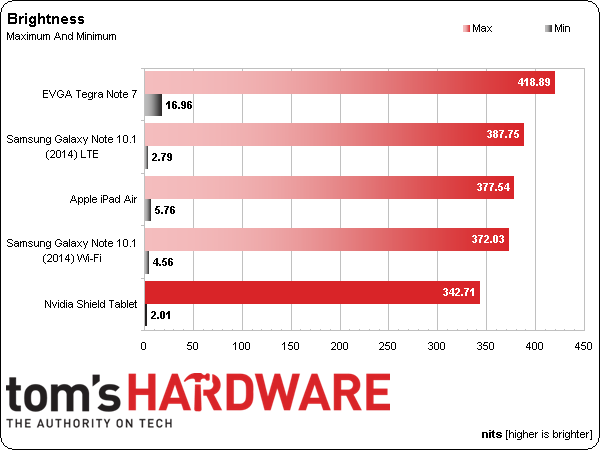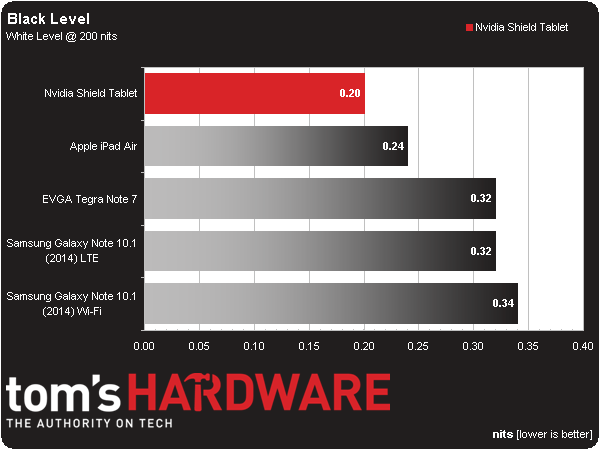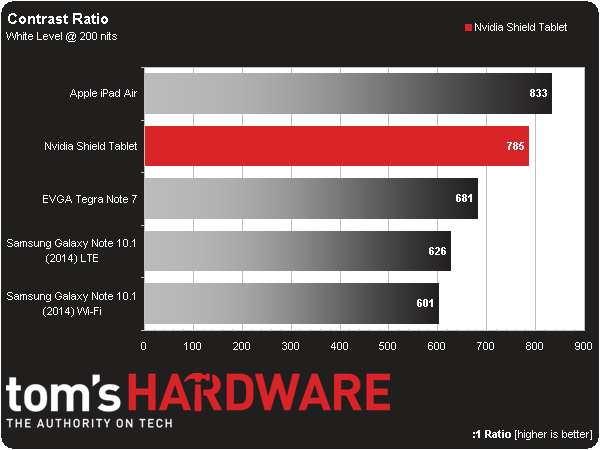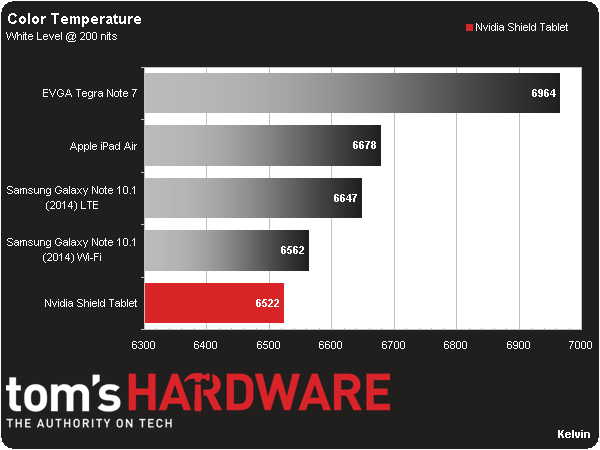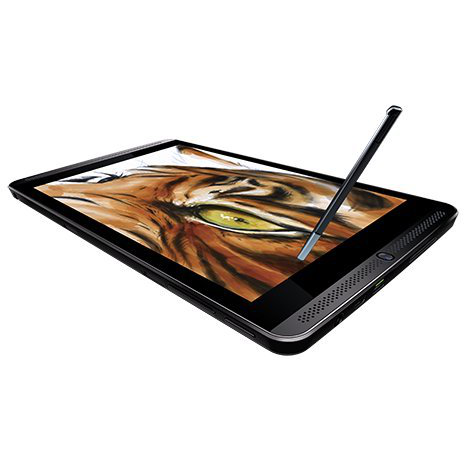Nvidia Shield Tablet And Shield Controller Review
The Shield Tablet, powered by Nvidia’s Tegra K1 SoC, deftly handles browsing and media playback duties. Combining it with the wireless Shield Controller transforms the 8-inch device into an exciting mobile gaming platform.
Results: Display Measurements
Brightness
Brightness (also known as white level) measurements are taken by recording the luminance output of each device displaying a full white pattern, with the device's brightness slider set to both minimum and maximum values.
The Shield Tablet takes a step backward from the Tegra Note 7 in maximum brightness. While not ideal for outdoor use, it’s still comparable to other tablets.
In order to make device comparison possible, the rest of our display measurements, along with our battery testing, are performed with the screen set to a standardized white level of 200 nits.
Black Level
Our black level measurement is the luminance output of a full black pattern after the luminance output of full white has been standardized to 200 nits.
The Shield Tablet’s black level is very low, even lower than the high-quality display in the iPad Air. This improves the contrast ratio and overall image quality.
Contrast Ratio
Contrast ratio is the difference between a full white pattern and a full black pattern.
Limited by its max brightness level, the Shield Tablet achieves a reasonable contrast ratio, falling just below the iPad Air.
Get Tom's Hardware's best news and in-depth reviews, straight to your inbox.
Gamma
Gamma compensates for the linear brightness levels displayed by a screen, versus the nonlinear way our eyes perceive light. A gamma curve of 2.2 is what we optimally want to see, as a screen with a gamma less than 2.2 appears brighter and with less shadow detail, while a gamma larger than 2.2 displays heavy shadows with fewer highlights.
The Shield Tablet again falls short of the Tegra Note 7, deviating furthest from the ideal value of all the tablets in our chart.
Color Temperature
Color temperature is a measurement in Kelvin, which is used to describe how “warm” or “cool” a given display is. Ideally, as long as you're not viewing your device in direct sunlight, this should be in the 6500 range. Higher color temperatures result in a cool, bluish hue, while lower temperatures deliver a warm or reddish tone.
Color temperature for the Shield is spot-on, improving color accuracy.
Color Gamut
Our volume measurements are compared against both the sRGB and AdobeRGB color gamuts. A reading of 100 percent on sRGB and 72 percent on AdobeRGB is the optimal reading for viewing the vast majority of digital consumer content. A lower reading is typically accompanied by an overly red or yellow image, and a higher reading is usually too blue/green.
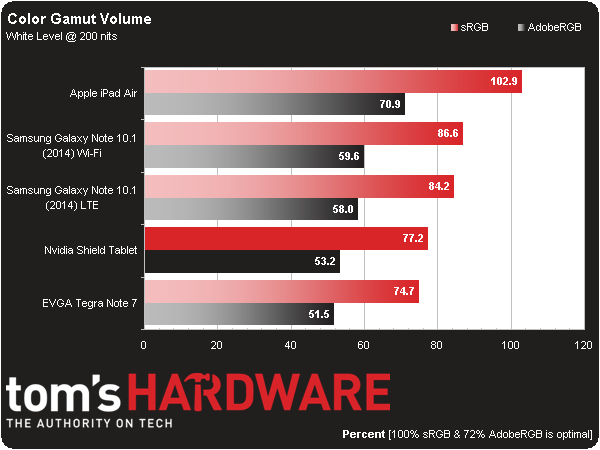

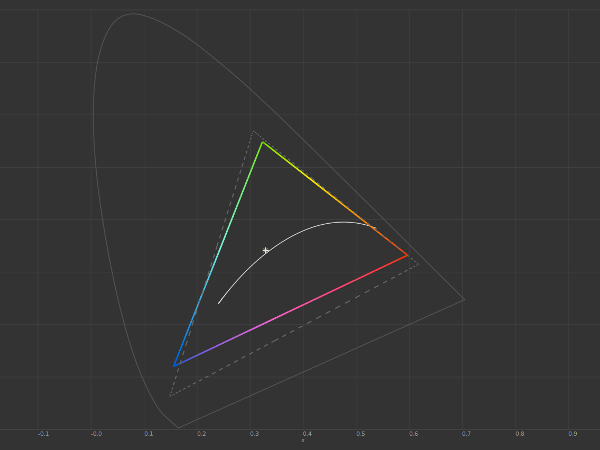
The backlight used in the Shield Tablet’s screen is not capable of covering the full sRGB color gamut, unable to even reach an 80% reading. This issue is most noticeable with reds and blues. In practical terms, there will be no color gradation beyond the 77.2% gamut coverage area. Rather than a smooth transition between color shades, you get a solid splotch of color. Apparently, Nvidia was willing to sacrifice some screen quality to hit its aggressive price point.
Current page: Results: Display Measurements
Prev Page Results: GPGPU Benchmarks Next Page Results: Battery And Throttling-
blubbey Those GPGPU benchmarks are ridiculous in comparison. It looks like a great bit of kit from what I've seen so far. A die shrunk Maxwell should be fantastic. Maybe even a lower clocked version just for power consumption? It'll still perform as well, if not better than the K1 at 750MHz (assuming 2 SMMs) I'd assume.Reply -
Memnarchon "Based on these results, Tegra K1 must be “a neural net processor; a learning computer” sent back through time to destroy all of the other SoCs that could lead a rebellion in the post-apocalyptic future."Reply
Lol this is epic! xD
Anyway, great and unique review. Especially for the so many GPGPU benchmarks.
Nvidia tablet at $299 seems to be a great buy. -
aberkae If maxwell brings double the performance per watt on the same node the next tegra chip on 20 nm node should be a home run for the companyReply -
deftonian Impressive, but I feel it's still missing that "umph" to get me to buy this and carry it around as an added device, next to my phone (Note 3). Maybe I just don't game enough on the android market or steam. Either way, I think it is impressive for a mobile gaming device and all the things it offers. I think they've started a great line and hope it grows into a successful tablet/gaming brand.Reply -
aberkae If maxwell brings double the performance per watt on the same node the next tegra chip on 20 nm node should be a home run for the companyReply -
gio2vanni86 The streaming a game while i'm at my friends house using my PC at home is what has me very interested. Plug into his TV and play amazing games he can only dream of. I'm in.Reply -
vithrell Just wait for Intel's Core M. It wont match the price (CPU alone will cost $300), but in fanless tablet form factor it wont have worthy competitor. Early GPU benchmarks give Core M 55k graphics score in Ice Storm, so more than 1.5x more power than Tegra K1. AND you can run full Windows on it. I wish Nvidia took x86 path with its cpu cores.Reply
